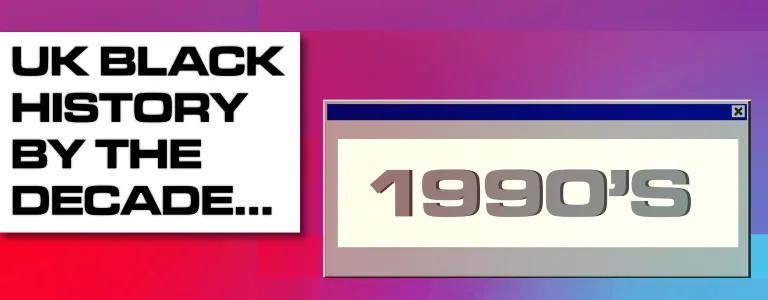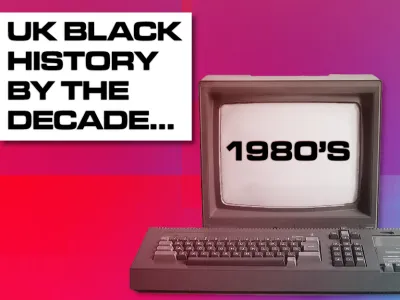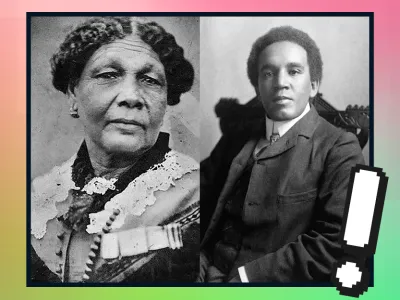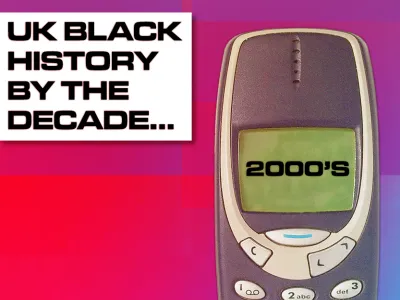
UK Black History By The Decade: 1990s
Include this article in your Skills Builder Journal. It could help you develop... 

Black history is British history. Fact. And we’re back with the second installment of our By The Decade series, looking at UK Black history. This time, we’re in the 1990s.
The 1980s was a decade striving for unity, justice and change for the Black community in the UK, as we explored here. And the start of a new decade meant finding more ways to bring people together - whether that was in celebration or protest, and everything in between.
1990 started off with a bang, when Choice FM began streaming on the airwaves. From Trinity Gardens in Brixton, Choice was Britain’s first 24-hour Black music radio station and brought joy and grooves to millions of people all over the country.
Speaking of millions, the 1991 UK census was the first to include a question on ethnicity and showed that Black Londoners numbered half a million people in a city of seven million, with the total Black population of the country being 890,727...or 1.6%. In the same year, the UK saw the formation of the Association for the Study of African, Caribbean and Asian Culture History in Britain, which aimed to “encourage research and disseminate information on the history of Black and Asian peoples in Britain.” Nice!
In 1993, A-Level student Stephen Lawrence was killed by a group of white men, in a racist attack, whilst waiting for a bus. Within three days of Stephen’s death, prime suspects had been identified. However, they were not arrested until two weeks later, and subsequently were not charged, due to ‘insufficient evidence’. The failure to capture the men who killed Stephen provoked outrage, not only with Stephen’s family, but with the wider Black community, and others across the country. Stephen’s parents began a campaign to shame the authorities into finding those responsible and to re-evaluate their racial attitudes. The fallout of Stephen’s murder, and the way it was handled by the police showed a huge cultural shift in attitudes towards racism and the police, and to the law and police practice within the country. The case would continue to be open for years to come.
1993 also saw new moves for England’s football team, when Paul Ince became the first Black captain. He went on to captain the squad for seven games.

The next couple of years were great for entertainment. In 1994, Moira Stuart (who was a presenter and broadcaster, and the first Caribbean female newsreader to appear on British national television) was named Best Female Television Personality by the Black Journalists’ Association, and in ‘95, the UK jungle scene was really picking up momentum and creating some absolute bangers. Goldie’s Metalheadz stable was running the underground scene and Alex Reece’s release of Pulp Fiction - which was a minimal beat, and didn’t use the popular fun breakbeats of the time - had a massive effect on the future of jungle and drum & bass.
Towards the end of 1995, a riot in Brixton broke out over the death of a young Black man. Wayne Douglas was in police custody when he died. He was being questioned about a burglary when he collapsed, and died of heart failure. The inquest into his death showed that he had been held face-down with his hands cuffed behind his back on four occasions. A peaceful protest against what happened was organised outside of Brixton police station, but violence was triggered by a standoff between the police and about 100 demonstrators. The riot lasted for five hours, and resulted in 22 people being arrested and charged with public order offences, theft and criminal damage, and three police officers being hurt. It has been said that the riot was started because ‘local residents were outraged by the death of a black man in police custody and saw the riots as an expression of alienation in an impoverished area devastated by race riots in 1981’.
These feelings of alienation were not new, and had been felt for many years. Figures show that inner city schools had been disproportionately expelling young Black youths; The New York-based Human Rights Watch identified Britain as the country with the highest incidence of racial attacks in Europe; Unemployment within Black communities especially in areas with high Caribbean, Pakistani and Bangladeshi Muslim populations - stood above the national average; and people felt a sense of powerlessness. So, in 1996, with a General Election on the way, Black volunteers at Charter88 and activists at The 1990 Trust began exploring ways to raise the concerns of the Black community. It was soon realised that the Black vote was potentially incredibly powerful. In over 50 seats the number of African, Asian and Caribbean voters was greater than its marginality. And so a mission to persuade the Black community to recognise this power and vote for a Black electore, and serve notice to the political parties that may ignore the Black vote was put into action. Operation Black Vote was launched and within ten months held over 100 meetings in schools and community centres around the country, distributed over 250,000 voter registration cards, 500,00 leaflets (in six different languages!) and over 200 articles appeared in national, and international, news. And the results were unprecedented. The Black electorate received more positive attention from the major parties than any election ever before, and for the first time in British political history, every candidate invited to a Question Time meeting came to listen to the Black electorate and argue their case. And as the months went on, the message began to get through even more. Operation Black Vote began to establish a platform that gave African, Asian and Caribbean communities in Britain a collective political voice - and those communities began using it.
In 1997, Stephen Lawrence’s case was brought back into the media attention when Home Secretary Jack Straw ordered a public inquiry to be conducted by Sir William Macpherson. Over the next year the inquiry examined the original Metropolitan Police Service's investigation and concluded that it was imcompetent and that officers had committed fundamental errors, including: failing to give first aid when they reached the scene; failing to follow obvious leads during their investigation; and failing to arrest suspects. It was also the first time that institutional racism was identified. The gang who killed Stephen however, were still not arrested.
Chris Ofili made history in the art world in 1998, when he was the first Black artist - and first painter since 1985 - to be awarded the Turner Prize, for his piece No Woman, No Cry. The painting was named after the famous Bob Marley song, and used acrylics, oils, and...elephant dung. Chris was known to use interesting techniques and materials in his paintings, often using resin, glitter or collage. No Woman, No Cry also sparked debate for its reference to Stephen Lawrence. His portrayal of a weeping woman, showed on closer inspection that the tears contain images of Stephen, and beneath the layers of paint the words ‘RIP Stephen Lawrence’ can be read.
Just as it began, the 90s ended with music. London’s UK garage scene exploded towards the end of the decade, when the Artful Dodger’s song Rewind smashed it’s way into the charts. The song became a number one hit, and Craig David quickly signed up as a solo singer. This time marked a golden overground period for vocal UK garage that would last the whole of the next decade, until the scene returned underground. Artists like Craig David, Shanks and Bigfoot, Oxide & Neutrino, MJ Cole, So Solid Crew, and Wookie all become Top of the Pops regulars and gained new fans of all ages, all over the country!
We’re aware that we may have missed a few things and that of course, UK Black history didn’t start in the 1990s. So feel free to let us know anything you’ve learnt and think is important to share over at @NCS!




